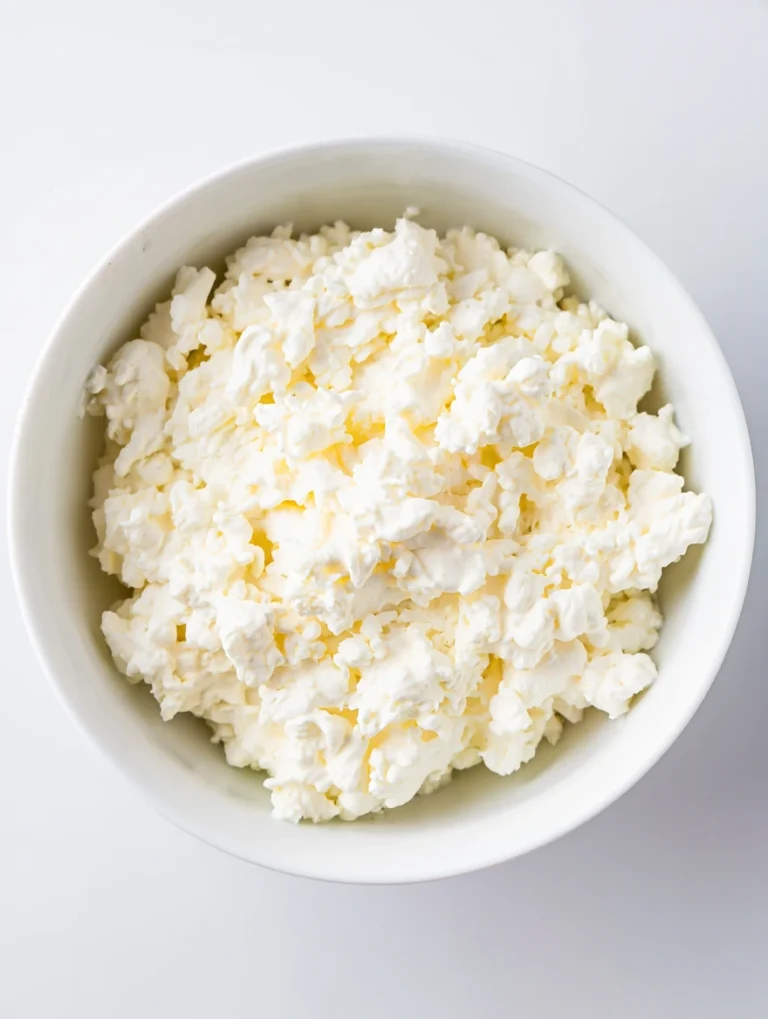Making cottage cheese at home gives you fresh, creamy cheese with just a few simple ingredients. This recipe transforms regular milk into soft, tender curds that taste much better than store-bought versions. Homemade cottage cheese has no preservatives and you control exactly what goes into it. The process is surprisingly easy and rewarding. You’ll see the magic of milk changing into cheese right in your kitchen. Even if you’ve never made cheese before, this beginner-friendly recipe will guide you through each step for perfect results every time.
Table of Contents
Reasons to Try Homemade Cottage Cheese
Homemade cottage cheese tastes fresher and creamier than what you find in stores. The texture features soft, pillowy curds that melt in your mouth. Making it yourself means you control the salt level and can adjust it to your taste. It’s also much more cost-effective than buying pre-made cottage cheese, especially if you consume it regularly.
The process is fascinating to watch as the milk separates into curds and whey – like a simple kitchen science experiment. Children especially enjoy seeing this transformation happen. Homemade cottage cheese also contains no additives, preservatives, or thickeners that often appear in commercial brands. The fresh flavor pairs perfectly with both sweet and savory foods, making it incredibly versatile in your cooking.
Where did Cottage Cheese come from?
Cottage cheese has a long history dating back thousands of years. It originated as a simple farm cheese made to use excess milk before it spoiled. The name “cottage cheese” comes from its origin in rural cottages where farmers’ wives would make this simple, fresh cheese using leftover milk from butter production.
In America, cottage cheese became popular during World War I when the government promoted it as an inexpensive protein source. Its popularity surged again in the 1970s as a diet food. The cheese-making process used in this recipe reflects traditional techniques that have been used for centuries, though modern kitchens make the process much easier than it was for early cheese makers who had to rely on natural fermentation.
Ingredients Notes
Milk: Use whole milk for the richest flavor and texture. While you can use 2% milk, the result will be slightly less creamy. Fresh milk produces the best results, but ultra-pasteurized milk will work too.
Vinegar or Lemon Juice: This acid helps separate the curds from the whey. White vinegar works well, but lemon juice adds a subtle citrus note that complements the cheese beautifully.
Salt: Fine sea salt or kosher salt distributes most evenly. The salt not only adds flavor but helps preserve the cheese.
Heavy Cream (optional): Adding a splash of cream at the end creates a creamier, richer cottage cheese similar to “creamed cottage cheese” found in stores.
Herbs (optional): Fresh chives, dill, or parsley can be mixed in for flavored cottage cheese.
How to Make Homemade Cottage Cheese
Step 1
Pour 1 gallon of whole milk into a large, heavy-bottomed pot. Heat the milk slowly over medium-low heat, stirring occasionally to prevent scorching.
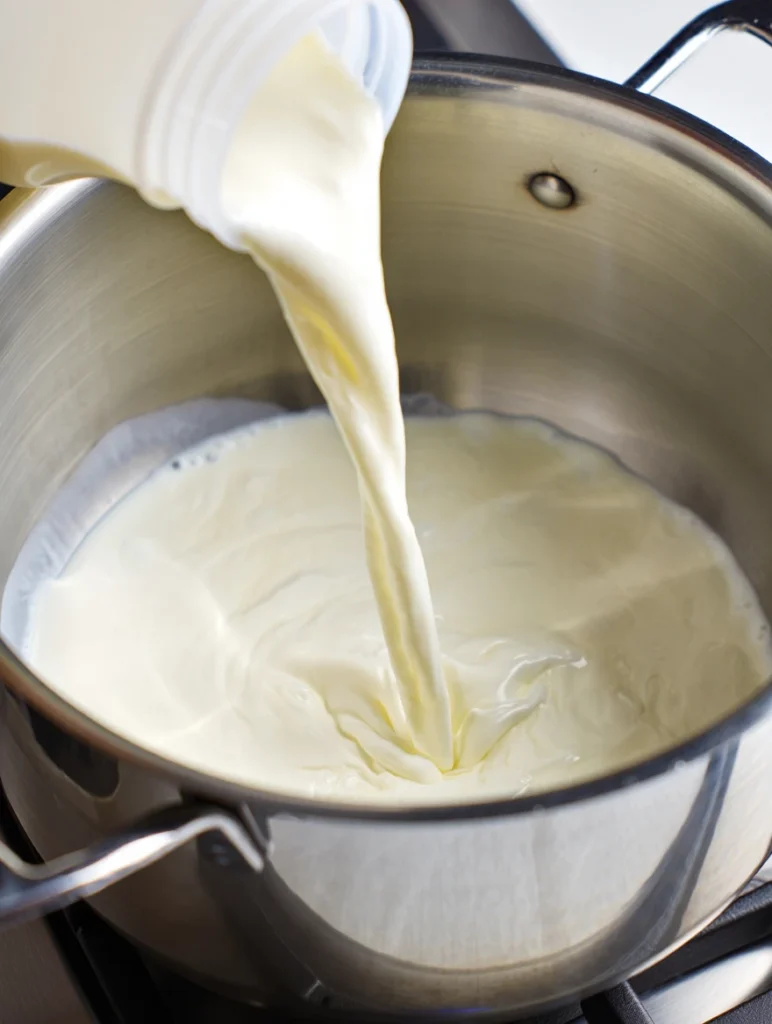
Step 2
Use a thermometer to monitor the temperature. Heat the milk to 185°F (85°C). This temperature is just below boiling and you’ll see small bubbles forming around the edges of the pot.
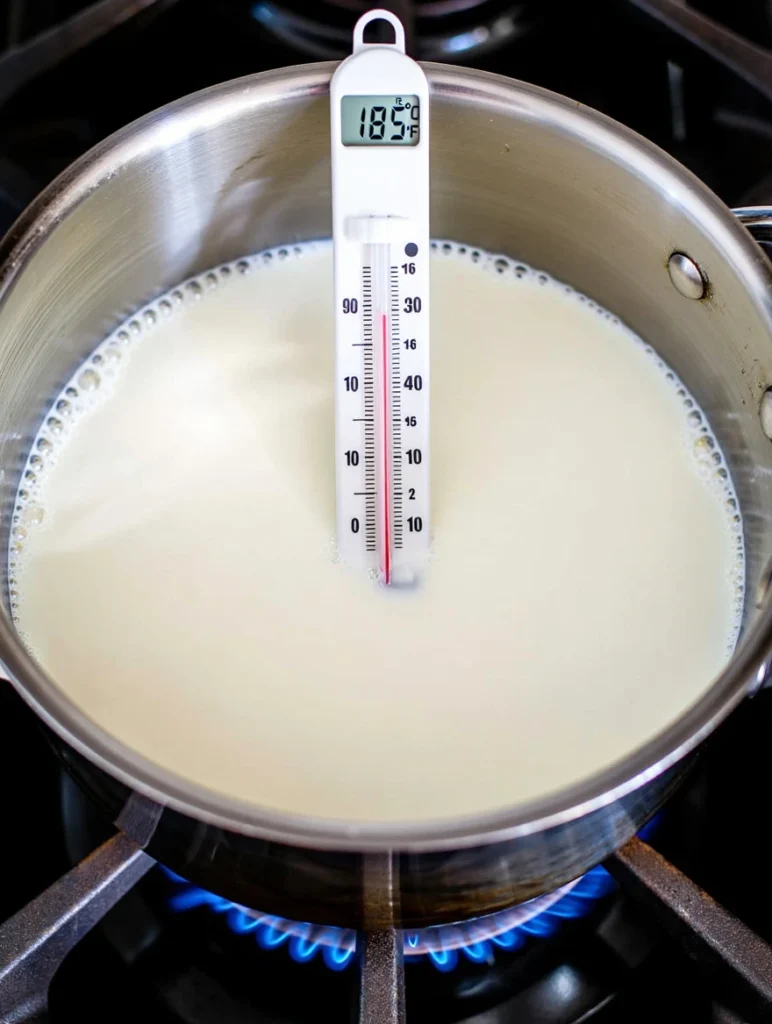
Step 3
Once the milk reaches temperature, remove the pot from heat and add ¼ cup of white vinegar or freshly squeezed lemon juice while gently stirring.
Step 4
Let the mixture sit undisturbed for 10 minutes. During this time, you’ll see the milk separate into white curds and yellowish whey.
Step 5
Line a colander with cheesecloth or a clean kitchen towel and place it over a large bowl. Slowly pour the curds and whey into the lined colander.
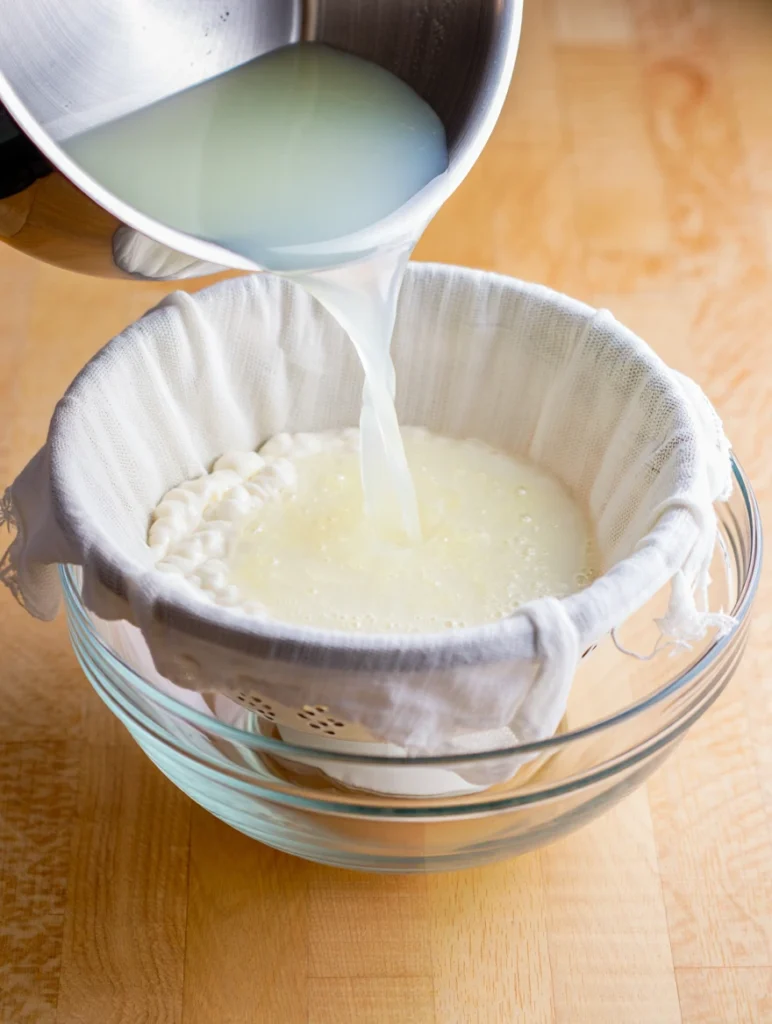
Step 6
Allow the curds to drain for about 30 minutes. For drier cottage cheese, let it drain longer.
Step 7
Gather the cheesecloth and gently rinse the curds under cold water for about 30 seconds, turning carefully to rinse all sides. This stops the acidification process and removes excess whey.
Step 8
Transfer the curds to a bowl and break them up gently with your fingers or a fork to reach your desired curd size.
Step 9
Add 1 teaspoon of salt and mix gently. If you want creamy cottage cheese, stir in 2-4 tablespoons of heavy cream or half and half.
Step 10
Taste and adjust seasoning if needed. Your homemade cottage cheese is ready to eat immediately or can be refrigerated.
What You Must Know About Making Cottage Cheese
The temperature matters greatly when making cottage cheese. Use a reliable food thermometer to ensure accuracy. Too low temperature won’t properly separate the curds, while too high might make the cheese tough.
Don’t skip the rinsing step, as it removes excess acidity and creates the mild flavor cottage cheese is known for. Without rinsing, your cheese may taste too sour.
The longer you let the curds drain, the drier your cottage cheese will be. For a wetter cottage cheese similar to most store brands, drain for less time.
Be gentle when breaking up the curds – rough handling can turn them into a paste rather than distinct pieces. Use your fingers or a fork with a light touch.
Helpful Tips
Save the whey that drains from your cottage cheese! This protein-rich liquid works well in smoothies, soups, or as a replacement for water when baking bread.
For a smoother separation of curds, you can add calcium chloride (available at cheese-making supply stores) to the milk before heating, especially if using ultra-pasteurized milk.
If your curds aren’t forming properly, try adding an extra tablespoon of vinegar or lemon juice.
Making cottage cheese works best with fresh milk that isn’t ultra-pasteurized, though both types will work.
Cool the curds quickly by placing the colander in an ice bath after the initial draining. This improves texture and extends shelf life.
Variations and Substitutions
Herbed Cottage Cheese: Mix in 2 tablespoons of fresh chopped herbs like dill, chives, parsley, or basil.
Sweet Cottage Cheese: Add a teaspoon of honey or maple syrup with a sprinkle of cinnamon for a breakfast version.
Mediterranean Style: Mix in chopped olives, sun-dried tomatoes, and a drizzle of olive oil.
Spicy Cottage Cheese: Add finely diced jalapeños or a pinch of red pepper flakes for heat.
Lower Fat Version: Use 2% or skim milk instead of whole milk. The texture will be slightly different, but still delicious.
Lactose-Free Option: Use lactose-free milk to make cottage cheese that’s easier to digest for those with lactose sensitivity.
Serving Suggestions for Homemade Cottage Cheese
Serve cottage cheese with fresh fruit like peaches, berries, or pineapple for a healthy breakfast or snack. For a savory option, top with sliced cucumbers, tomatoes, and a sprinkle of black pepper.
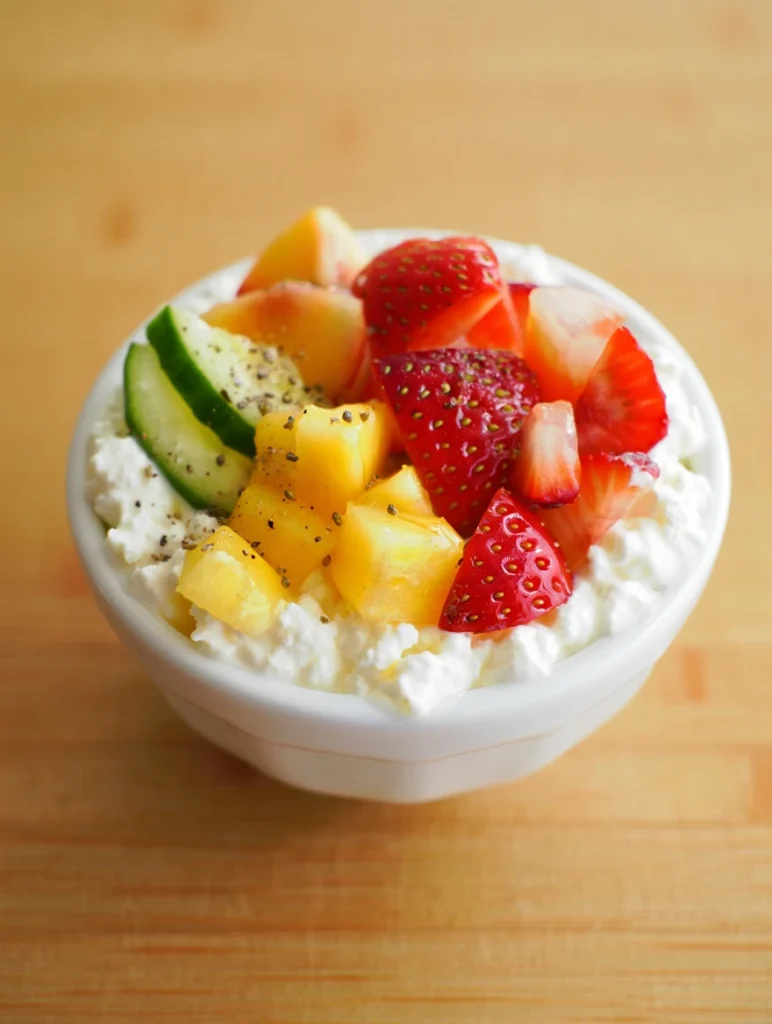
Use your homemade cottage cheese as a spread on whole grain toast, topped with sliced radishes and a drizzle of olive oil. It also makes a great filling for twice-baked potatoes or stuffed pasta shells.
For a simple lunch, serve a scoop of cottage cheese on a bed of mixed greens with a light vinaigrette. It pairs particularly well with beets, walnuts, and arugula.
In summer, try it with watermelon and a sprinkle of mint for a refreshing combination of flavors and textures.
Storage
Store your homemade cottage cheese in an airtight container in the refrigerator. It will keep fresh for 5-7 days. The cheese might release some liquid during storage – simply drain this off or stir it back in before serving.
For longer storage, you can freeze cottage cheese, though the texture will change somewhat after thawing. Frozen cottage cheese works best in cooked recipes rather than eaten fresh.
If your cottage cheese develops any off smell or appearance, discard it immediately. Since homemade versions lack preservatives, they don’t last as long as commercial products.
Nutrition Facts (Per Serving)
Based on 1/2 cup serving (about 113g) of homemade cottage cheese made with whole milk:
- Calories: 110
- Protein: 13g
- Fat: 5g
- Carbohydrates: 3g
- Calcium: 138mg (14% of Daily Value)
- Sodium: 380mg (16% of Daily Value)
Note: Nutrition values will vary based on ingredients used, especially the type of milk and whether cream is added.
Frequently Asked Questions about Homemade Cottage Cheese
Why didn’t my milk separate into curds and whey properly?
This usually happens when the milk isn’t acidic enough or didn’t reach the right temperature. Make sure your milk reaches 185°F and try adding an extra tablespoon of vinegar or lemon juice. Also, ultra-pasteurized milk sometimes struggles to form good curds.
Can I use milk alternatives like almond or soy milk?
Traditional cottage cheese requires animal milk proteins to form curds. Plant-based milks don’t contain the same proteins and won’t form cottage cheese. There are special recipes for vegan cottage cheese using tofu that mimic the texture.
How can I make my cottage cheese less sour?
Thoroughly rinse the curds under cold water to remove excess acidity. Also, make sure you’re not using too much vinegar or lemon juice. Adding a little cream at the end helps balance any remaining sourness.
Why is my cottage cheese too dry?
You likely drained it too long. For a moister cheese, reduce draining time to 15-20 minutes. You can also add more cream or even a splash of milk to already-made cottage cheese to increase moisture.
Is homemade cottage cheese healthier than store-bought?
Homemade cottage cheese contains no preservatives, stabilizers or additives found in many commercial brands. You control exactly what goes into it, including the amount of salt. This makes it a cleaner option for those avoiding food additives.
Can I use this cottage cheese in baking?
Yes! Homemade cottage cheese works wonderfully in cheesecakes, lasagna, blintzes, and baked goods. For smoother texture in baking, you can blend it briefly to break down the curds.
Cottage Cheese Recipes You Must Try:
Moist Cottage Cheese Banana Bread Recipe
High-Protein Cottage Cheese Bagels Recipe
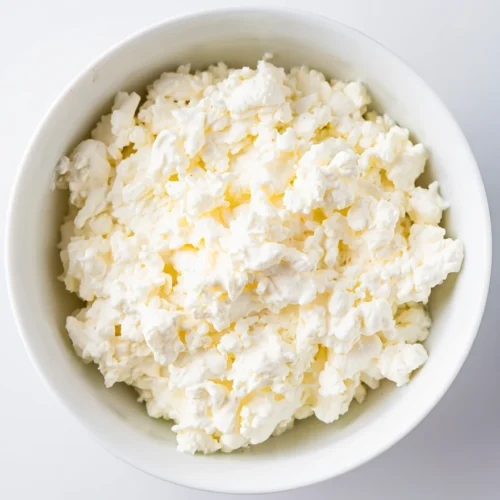
How to Make Cottage Cheese at Home
Ingredients
- 1 gallon whole milk
- 1/4 cup white vinegar or fresh lemon juice
- 1 teaspoon salt
- 2-4 tablespoons heavy cream optional
- Fresh herbs for flavoring optional
Instructions
- Heat milk to 185°F in a heavy-bottomed pot
- Remove from heat and add vinegar while stirring gently
- Let sit for 10 minutes until curds form
- Drain in a cheesecloth-lined colander for 30 minutes
- Rinse curds gently with cold water
- Break curds to desired size
- Mix in salt and optional cream or herbs
- Serve immediately or refrigerate
Leave a Reply
Recipe Ratings
There are no reviews yet. Be the first one to write one.
